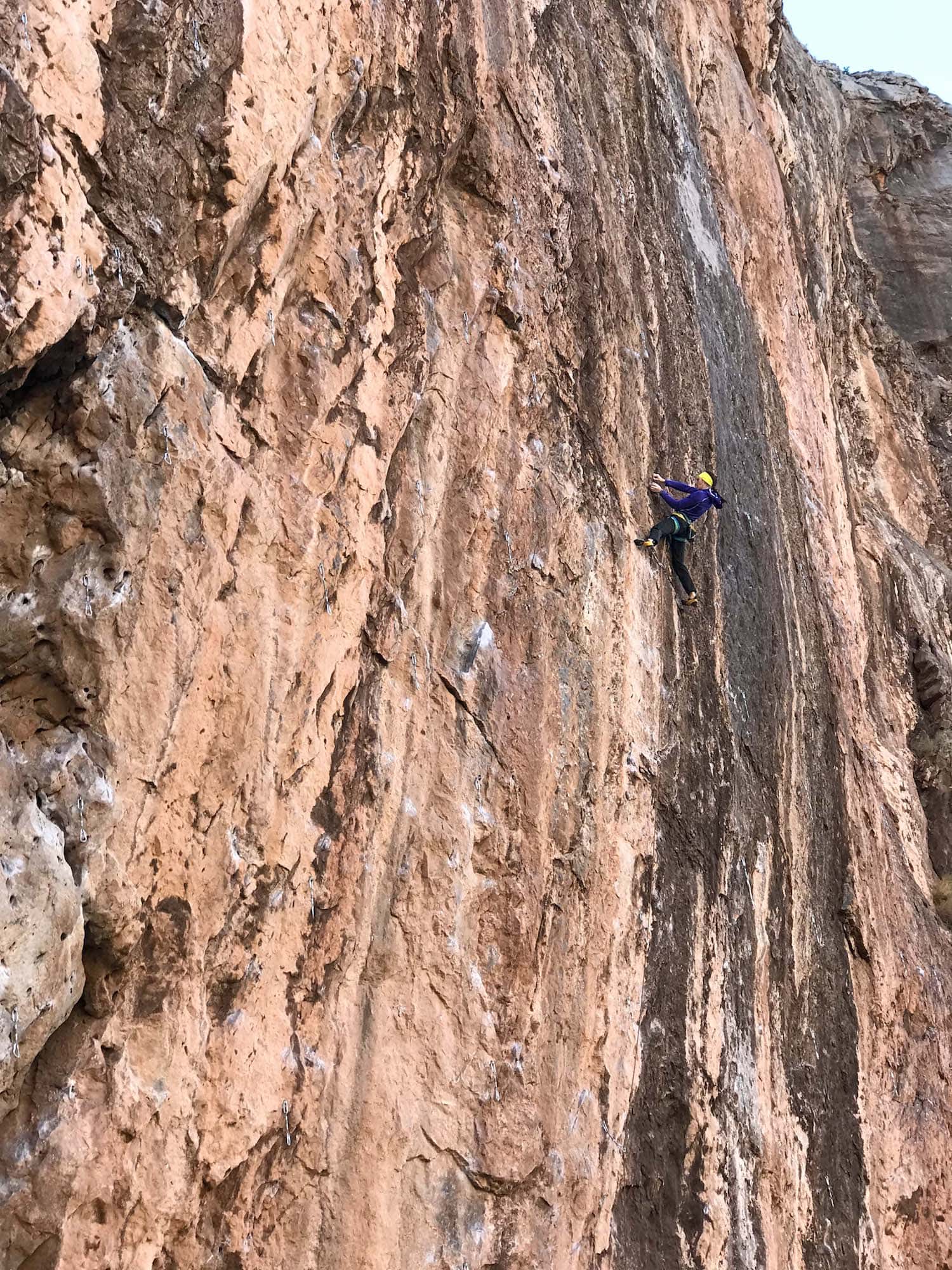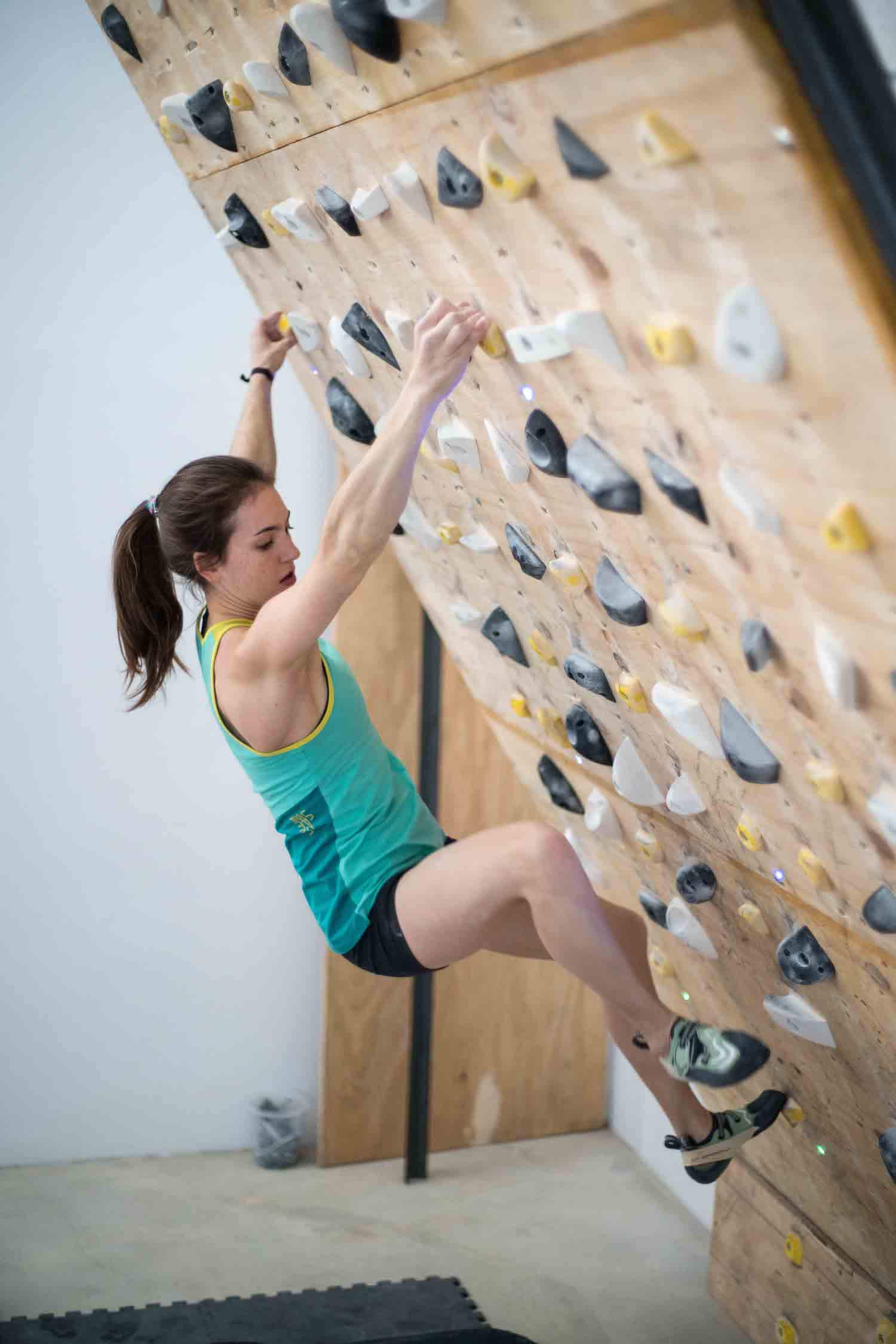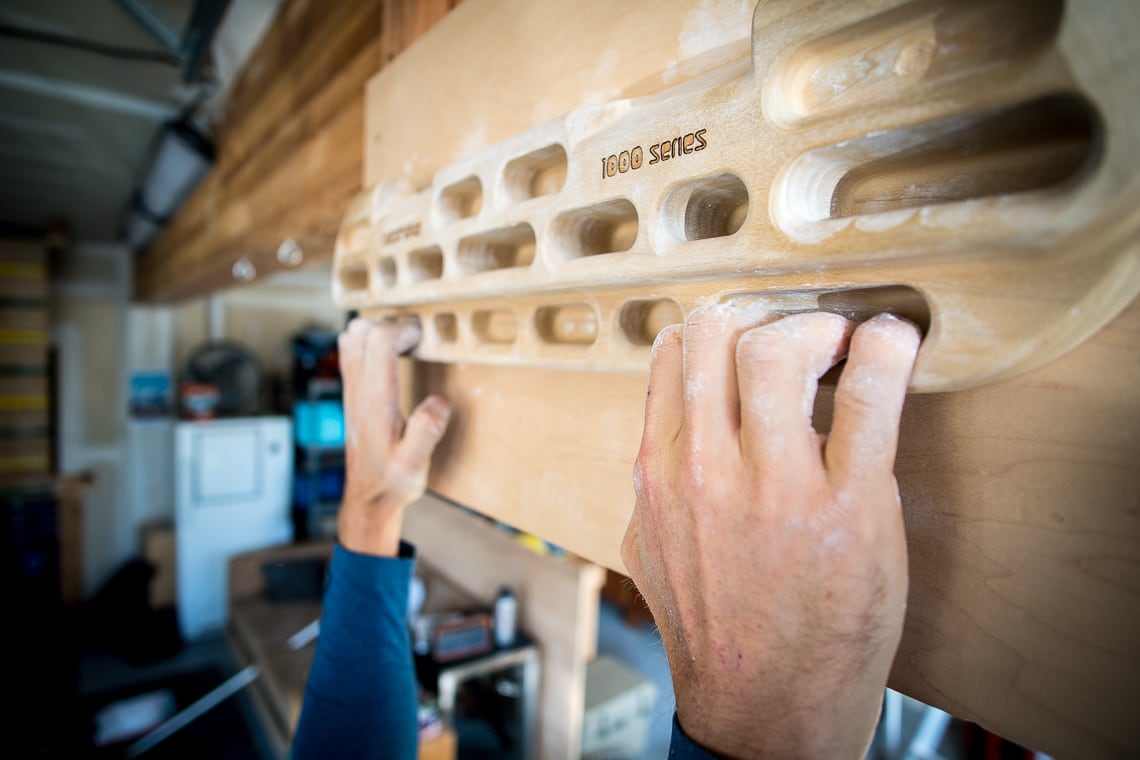This week one of America’s most iconic sport-climbing testpieces saw both its first and second female ascents over two consecutive days. Michaela Kiersch, 23, clipped the chains on Necessary Evil on February 6 for the route’s long-awaited FFA. The next day, 27-year-old Paige Claassen followed suit with her own redpoint.
As a longstanding project that was first bolted by Boone Speed in 1989, Necessary Evil, a striking direttissima up the Blasphemy Wall of the Virgin River Gorge, wasn’t freed until 1997 following a long campaign by a 16-year-old Chris Sharma. At 5.14c, Necessary Evil is most often referred to as “hard for the grade” by just about everyone who has ever climbed it.
Prior to the start of the VRG season, Paige found herself in a unique predicament for a professional climber: she found herself working a grueling 14-hour-per-day, 6-day-per-week job on her husband’s grape farm in Africa. Crunched for time, yet unwilling to give up her dream of sending Necessary Evil, Paige, with the help of her training sensei Justen Sjong, devised a routine that allowed her to get fit and strong with just one hour per day.
We invited Paige to share an overview of her training regimen. Given that so many of us feel crunched for time, Paige serves as an inspiration in that, no matter how busy you think you are, getting stronger and fitter CAN be done with a few basic home-training tools and just one hour per day. Given that so many of us face similar time crunches in our own lives, we hope you read this story and it gets you inspired to stop making excuses and start getting after it.

Ifirst tried Necessary Evil in 2014 while project shopping on a trip to the Las Vegas region. I had originally arrived with the intention of trying to climb 5.14d, but quickly realized, as I have many times before, that the significance of the route matters more to me than the grade. Necessary Evil ticked all the boxes: it’s an iconic line with a rich history, it’s held its grade of 5.14c over many ascents and attempts by climbers around the world, and it sits on one of our country’s most stunning limestone walls. I’ll admit, the VRG is not the most serene location, but the highway has never bothered me. Neither did the sharp crimps or bottom boulder problem. It was always the upper crux—which is actually the same crux as Route of All Evil (5.14a) as the two climbs converge and share the same finish—that tripped me up.
That move is powerful. I was not.


A few years later, I found myself in a conundrum of sorts. Necessary Evil sat at the top of my list of dream lines to complete, yet its prime season is in winter, namely November to February. My husband farms eating grapes in Namibia, and the November-December harvest season keeps us locked into 14-hour work days for 8 solid weeks, every year. My only chance at ever sending Necessary Evil would be to train throughout the work season. It seemed like it might be impossible to show up at the VRG, prepared to climb at my limit, after two months of long, stressful, exhausting days in the pack house. It wasn’t ideal, but neither was giving up.
For me, climbing is primarily a mental sport. Training, however, is predominantly physical. I wouldn’t have the mental energy to motivate myself after long work days, let alone plan and follow through on workouts. I knew my strengths in technique, footwork, and finger strength, combined with my projecting experience, could be enough to give me a good shot at Necessary Evil. I had a solid base. What I truly lacked, however, was power.

I reached out to my friend Justen Sjong, a professional climbing training whom I’ve known for many years. I admire many of his climbing achievements, as well as the laid-back-but-no-bullshit balance he strikes in his attitude toward training and life. I sent him the parameters I was working with:
Dear Justen, I’m willing to devote 1 hour, 5 days a week to train for my dream proj. I only have a moon board, beast maker, rings, TRX, and dumbbells. Also, it is over 100 degrees every day so I am unwilling to run or do any cardio. I will have zero mental energy to dedicate, so I don’t want to do any visualization or mental training. 1 hour a day of physical training, that’s it.
Justen is a bit sarcastic but he tells it like it is. If he thinks your footwork is sloppy or your triceps are weak, or your outfit is goofy, he’ll just tell you. Honesty is an important quality in a coach. I was surprised he didn’t scoff at my request. Instead, he promptly wrote me a two-month strength training program and left me to it. Exactly what I wanted.
Most importantly, I never missed a day…
Starting in November, I woke up each day at 4:30 or 5 a.m. to start working on the farm. I’d finish anywhere between 7 and 9 in the evening. We don’t take lunch breaks, so that wasn’t an option for training. If I could, I’d sneak away for an hour late morning to get my training in. Otherwise, I’d do it after work. We didn’t work on Sundays, so once a week I would train for two hours. Most importantly, I never missed a day of training or skipped an exercise.
Each day consisted of some combination of the following:
Moon Board
Moon Board workouts included: Projecting hard boulders, repeaters, 4x4s, or lock-offs with a 3-second hold. I found that one day’s project could be the next day’s repeater, which was motivating. Surprisingly, I never really got sick of the Moon Board, perhaps because I knew it was all I had. One month in, I changed the angle from 40 degrees to 30 degrees, allowing me to climb harder boulders at a lower angle.

Rings
One-arm negatives and jumping pull-ups. The one-arm negatives were actually my favorite because it was cool to see my progress each week.
Beastmaker Hangboard
Repeaters on the same grip, dead hangs with weight, or slow lowers (negatives) with pauses at various angles. I never did a full hangboard workout. Instead, I just focused on specific hangs. I think this helped with shoulder stability and lock-off engagement, whereas the Moonboard is what really kept my fingers strong.

Dumbbells
Biceps curls, triceps curls, chest presses, and a bunch of CrossFit-sounding names that I had to Google. I lifted weights about three times per week. I was nervous I was going to get bulky throwing weights around, but it didn’t happen. One look at my arms, I’m not sure they even could.
TRX
A longtime favorite training apparatus for planks and core exercises. With a little ingenuity, can build your own for $13. This is a great supplement to dumbbell exercises because you can build up even more shoulder stability and core strength.
Therabands
I used these for rotator-cuff prehab. It’s boring but super crucial, as I never felt any tweaks throughout my training.

Regaining Fitness for Necessary Evil with Side Routes
After two months of long work days and short training session, I arrived at the VRG in mid-January and hopped straight onto Necessary Evil after a few warmups. I hadn’t tied in or climbed outside in 3 months. The beta came back quickly, and I surprised myself by doing all the moves without too much difficulty. I had power!
Over the next few days, I linked sections, re-familiarized myself with the micro foot beta, and realized that I had nowhere near enough fitness to send this route.
As it turns out, it’s tough to train endurance on the Moon Board if you only devote seven hours a week to training. On the other hand, I felt encouraged that the individual moves felt significantly easier than they had four years earlier. I could envision myself linking all the sections together. All I needed now was a bit of endurance.
What I learned is that limited time doesn’t have to be a limiting factor…
Fortunately, with a decent base, I think that endurance is relatively easy to build in just two weeks. After projecting Necessary Evil a couple times each day, I incorporated “bonus routes” afterward. I’d choose a 13a to climb as a side project. Interestingly, this is the same approach Sharma used when he sent Necessary Evil two decades ago. He’d try the main proj in the morning, then slowly but steadily tick off other, easier routes in the afternoon. I think this is a good approach. In addition to building fitness, I knew these side routes would help keep the new muscles I had built activated and engaged.
Three weeks in, my psyche and confidence were high. I was reaching the crux move with enough power and didn’t feel nearly as pumped as I did in the beginning. Plus, we had an awesome crew at the crag. Every single day there were more ladies than gents at the Blasphemy Wall. We sang, danced, laughed, and kept the climbing vibe light, as I believe it should be.
After two rest days to make sure I was fully recovered and had thick skin, I climbed up to the crux, crimped super hard, kept my body into the wall, and stuck the jug that marks the end of the crux. With numb toes and pumped forearms, I enjoyed the last 20 meters of Necessary Evil, knowing I was climbing a life goal.
The moral of the story isn’t that you only need to train one hour a day in order to climb at your limit. What I did learn, however, is that with the right mindset and the application of a very specific training routine targeted at obvious weaknesses, limited time doesn’t have to be the limiting factor. All the time in the world at the fanciest gyms with the most hipster workout classes won’t get me up my project if I’m not making the most out of each moment of training. Sometimes a good ol’ max effort bicep curl might be just the trick.
More Links, Stories, and Resources
Custom training programs by Justen Sjong
Training With Justen Sjong, Part One
Training with Justen Sjong, Part Two



Thank you for the article, Andrew and Paige! I’ve tinkered a bit on the moon board so I was curious about doing anything other than limit boulders on it. Is there any chance you could explain these:
Moonboard: repeaters, 4x4s, or lock-offs with a 3-second hold.
Thanks
I liked this article quite a bit because it gave super specific examples of how a highly-prioritized and specialized trianing regimen might look.
BUT, I don’t buy the proposed moral of the story (or maybe I think it’s misleading). We’re talking about a person who was doing (presumably (please correct me if I’m wrong)) physically intensive labor for 14 hours a day, 6 days a week. The training could afford to be very short and very specific to climbing because general strength was being tested and improved every day at Paige’s day job. Sure, make the most out of your training time. But if I, a desk warrior with an RSI, want to achieve the same kinds of gains as Paige did in the same amount of time, I’m going to have to spend a large amount of time each day working on my general fitness and strength in addition to my climbing-specific strength.
I found the dumbbell paragraph very interesting because I’m surprised the myth of “lifting weights makes your muscles huge immediately” reaches into sports with a strength component like climbing. Thank you for pointing it out, because if such a high level athlete thought this then there are certainly people reading this who will learn something new. People with big muscles train and eat their butts off (er, on) for years to achieve those results. But (again, presumptions are made on the daily activities on the farm) did you really think throwing around some dumbbells was going to make your muscles grow more than (literally) throwing around (likely) heavier weight on the farm all day? Again, thank you for bringing this up and hopefully helping to dispel this myth.
The moral of the story as I read it isn’t about training efficiency because Paige was training for 14 hours a day in a way. The moral I read is: strength is never a weakness. Make your body strong, lift some heavy weight, and then focus your newfound strength into developing climbing-specific strength and skills. Sometimes we worry too much about the climbing and not enough about the body performing the movements.
Keep up the good work and best of luck on the next project!
I agree that the “moral” of the story was a bit off and the title a little click bait.
It should be no surprise, that someone like Paige who has been an elite climber for a long time and has climbed 5.14c before as recently as Thor’s Hammer, is able to maintain that grade level with a focused training plan.
Namibia and South Africa are different countries.
super useful. thanks for the multitude of specific recommendations!